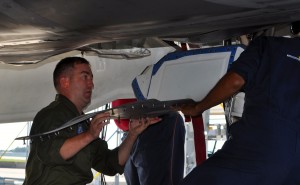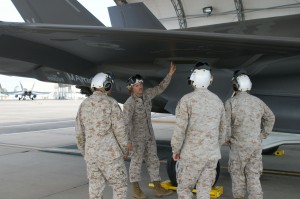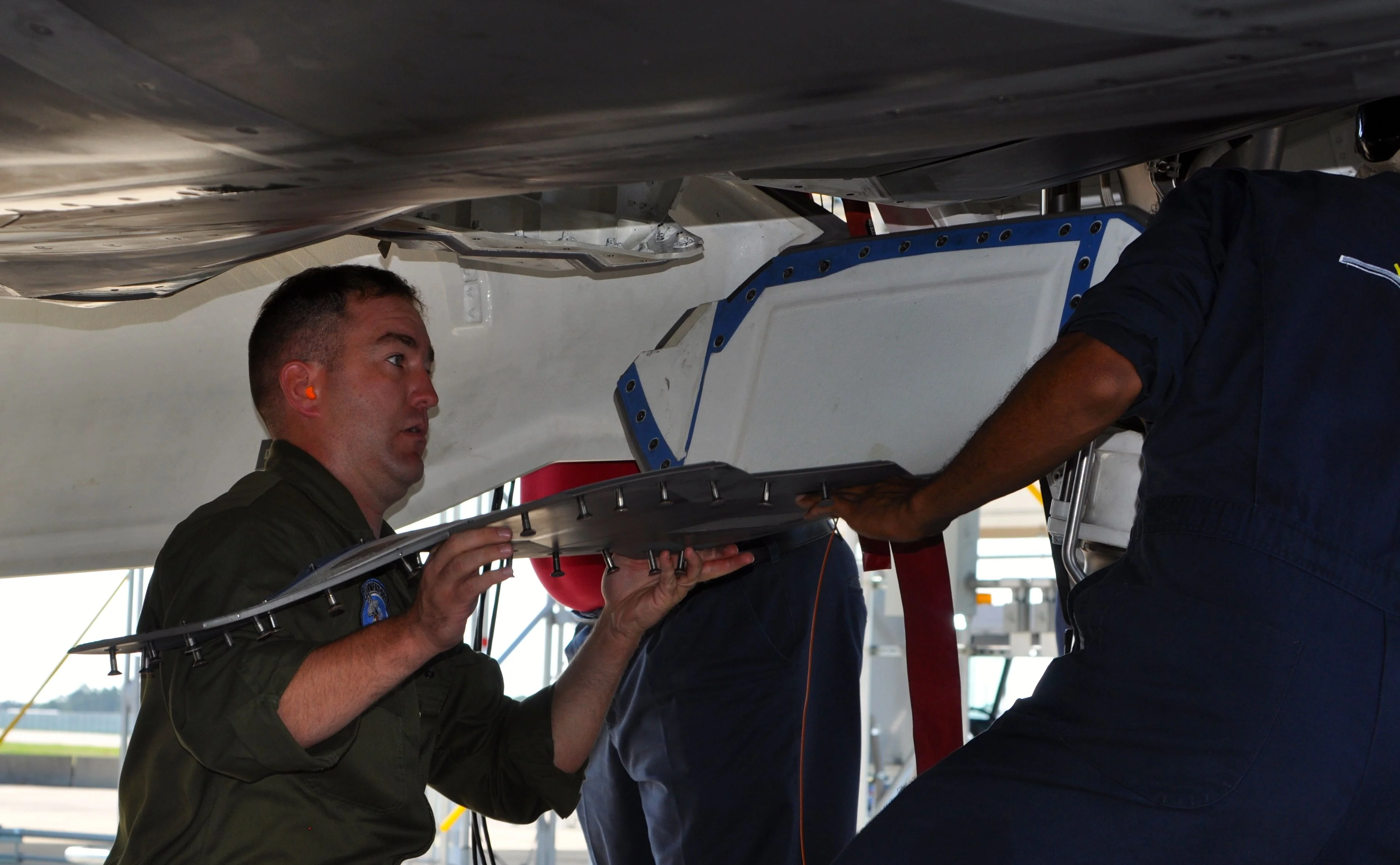2012-10-22 By Robbin Laird
The F-35 is a fifth generation aircraft, which has been characterized by one of its most notable pilots as a “situational awareness machine.”
I referred to in a Defense News op ed in 2005 as a “flying combat system.”
But too often in a platform centric acquisition conversation, the core impact of the F-35 as a global fleet is not fully understood or considered.
The F-35 is the first combat aircraft to be built in numbers in the new digital age. The plane speaks a universal language. Because the F-35 was born at a time when DoD was keenly focused on implementing Unique Item Identification (UID) and Radio Frequency Identification (RFID) technologies, the plane was built from the start with modern logistics tool sets in mind.
In effect, this means that the aircraft speaks a universal or global logistics language.
This common language and the digital management, which is enabled by this language, allows for the F-35 fleet to be managed globally in an historically unprecedented manner.
The digital foundation for the maintenance of the F-35 is not about the platform; it is about the fleet.
When discussing core developments such as shaping a Pacific strategy for the 21st century, the role of the F-35 in terms of commonality both in support and capabilities is an essential STRATEGIC element.

The capacity to build hubs and training ranges in the Pacific – hubs and ranges in Canada and Australia – and hubs in Japan, South Korea, Singapore, Alaska, Hawaii and Guam – provides an opportunity to re-shape how sustainment can be done in around the world and with it a significant boost to sortie rates and hence operational capabilities.
Allies will clearly make their own choices, but the potential for such a development is inherent in the technology and approach to the program.
A man intimately aware of the impact of logistics and sustainment on operations is Lou Kratz, Vice President, Logistics and Sustainment, Lockheed Martin
Corporation. He is responsible for coordinating Lockheed Martin’s logistics and weapon system sustainment efforts. Mr. Kratz leads Lockheed Martin’s Automatic Identification Technology implementation, including RFID and UID.
Previously, Mr. Kratz served as the Assistant Deputy Under Secretary of Defense (Logistics Plans and Programs), within the Office of the Deputy Under Secretary of Defense (Logistics and Materiel Readiness). As such, he was responsible for guiding the DoD’s logistics transformation to meet the operational requirements of the 21st century.
I had a chance to discuss with Kratz how the F-35 program could shape a 21st century strategic breakthrough with regard to global sustainment.
Question: What will be the potential impact of global sustainment of the F-35?
Kratz: From the very beginning, the objective of F-35 sustainment was to enable global integrated allied operations. That objective drives a sustainment structure that enables two goals.
First, it ensures integration, not just interoperability, right across the U.S. and allied fleets.
To achieve that integration, extremely tight configuration control is required. There needs to be truly common parts across the aircraft, common technical data, configuration identification by platform, and consistent maintenance and engineering activities across the global fleet.
The reason that is so important is we want to ensure that the United States and our allies do not encounter earlier challenges that we have with the current fighter force Previously, we all bought the same platforms, but we went our separate ways. Over a period of years, those platforms may be interoperable, but they’re not integrated.
The second goal of global sustainment is to enable consistent sustainment service to all partner and allied nations.
This means that when one particular partner nation is deployed in the region of another partner nation, the parts, the tech data, the maintenance actions can all be performed within that partner nation.
The U.S. and our allies will receive a huge benefit in terms of the ability to deploy rapidly and not have to take the entire logistics infrastructure with them. We don’t have to push the logistics package with us. It will be there, and we will have an option to draw upon our allies in several regions to sustain the aircraft, generate sorties, and fly missions in an integrated manner.
Question: What is the current situation, as the U.S. would surge aircraft in the Pacific?
Kratz: It doesn’t matter whether it’s the Air Force or the Navy, but we have to deploy our aircraft with all their enabling intermediate level and operational level maintenance and squad capabilities. They must bring reserved material and their own enabling IT systems.
They must bring all the special test and tooling that they need to perform organizational and intermediate maintenance.
The best example I can give you is in Southwest Asia where the United States and our allied launched Operation Enduring Freedom. All of the countries showed up with their own C-130s. Those aren’t fighters, but the principle’s the same. We saw the United States, The Netherlands, and the UK all fly in their C-130s.
The first thing they offloaded was the maintenance equipment, the test stands, the automatic test equipment, and the spare parts for each one of their C-130s. You had three sets in that particular example geared up to support fundamentally the same aircraft. We do the same for the F-16s and the F-15s and the Harriers today.
The F-35 was designed to end this redundancy.
Both the air vehicle and its associated supporting infrastructure have been designed to enable any partner nation to land, coordinate, and work with any other partner nation to put that aircraft back into full combat operation.

To answer your specific question, as we deploy U.S. forces into the Pacific, we have an option; we can deploy those forces with their specific unit equipment and spare parts.
Or we can rely upon the regional capabilities that will already be resident in the Pacific theater to support those aircraft.
And that choice and that decision would be made based upon the operational requirement where you’re going to actually bed down the aircraft, and how fast we have to get there.
Question: To surge combat capability, you actually have to carry a significant amount of the infrastructure with you. A significant savings built into the program is that you don’t have to bring that entire infrastructure. You can save the cost of moving that infrastructure by air or sea, as well as the fuel costs and using up assets.
Kratz: Your characterization is correct.
The F-35 is the first aircraft to have been designed with the critical performance parameters of logistical support in mind.
This includes the footprint that has to be air lifted or sea lifted to support the aircraft. So the number of containers, the square footage that’s displaced by the equipment and the special test stands all have to meet the critical performance parameter that’s part of the operational suitability of the aircraft. It’s never been done before.
The intent was to physically do what you mentioned earlier, which is reduce the time to deploy, and second, the cost, and wear and tear on our mobility assets either ship or air. Such capability is a key performance parameter, which will be tested during the operational phase that drives both the design of the aircraft, and the design of the support system. We want to ensure that we can meet the operational availability and sortie generation rate requirements while not dragging that entire logistic infrastructure with us.
We actually designed the air system to minimize how much we have to take with us.
Question: And these are metrics that one can measure over time the improvement on logistic support for example.
Kratz: Yes, and they have to be demonstrated during operational tests.
Question: This will have a significant impact on the ability to surge force to an F-35-enabled region.
Kratz: It will. The F-35 enables all the Services to dramatically reduce the equipment that is necessary to maintain the aircraft, thereby freeing up both air and sea lift capability to bring in combat elements which then allows you to close the theatre faster and enable more rapid responses to emerging threats.
Additionally, because our allies are all over the world, not only do they have the support structure, they have the aircraft.
Our allies become a key part of that coalition force which is already in theatre. So you reduce both the time, and the cost associated with the total force capability buildup.
Question: I have written about hubs built by allies to support themselves and thereby open up the capability to do so for regional partners or allies which plus up regional capabilities by surging. Could you talk to the hub possibility?
Kratz: The original intent of the F-35 program was to build upon best commercial practices, and if you look at the commercial airline business, they have hub-based systems.
When we fly to the Pacific as citizens, United Airlines doesn’t land at an airport and bring half their maintenance with them.
They have a maintenance hub at the airport to get their aircraft back in service.
The logic of the F-35 design, the reason it was so important to maintain the global fleet, was to allow two things. One, the fully integrated operations, and second, fully integrated sustainment, which includes the evolution of a global support network or global hub as you refer to it where you can service the aircraft quickly, regardless of which nation actually owns the aircraft.
Question: Again, how does this contrast with current practices?
Kratz: Let us take the example of the F-18s, which the Australians and the Americans deploy. The United States Navy flies F-18s, but when the United States Navy needs maintenance work on their F-18s, that’s done right on the carriers or they bring the aircraft back to the United States.
With the F-35s, you would service that aircraft in that partner nation. It would not have to come back to the United States to perform that repair.
Question: This will clearly take time to achieve the full up global sustainment capability. And it will require significant rethinking of the mental furniture, which the Services have.
I have written about the Osprey at 5 and it has taken 5 years of deployments to start really using the aircraft as a full up assault asset. I believe it takes time, but the potential for global sustainment is clearly there within the technology.
Kratz: The F-35 is the first tactical aircraft system that from the beginning was directed to design the sustainment concurrent with the air vehicle to optimize operations. Because of that, the United States and our partner nations have invested roughly $2 billion over the last decade to develop, and establish what I’ll call a 21st century sustainment capability.
The challenge we have is that 21st century structure comes to advancing in technology and information systems that have to be developed and proven. And so you’re correct, the expectation set in many cases, runs ahead of where the program is at this point in time.
The support system – including the IT system which enables it – will mature over time, and we estimate that time to be about 200,000 flight hours.
With 200,000 hours, the operator, the maintainers, and the enabling infrastructure will mature, and we’ll see how it really does in real operations.
We will make adjustments to both the aircraft and sustain infrastructure to enable the force to grow and capitalize on the inherent capabilities of the total system, air vehicle, and its enabling infrastructure.
Another important piece, which we’ll have a much better handle on after 200,000 hours, is the number of maintainers that we need at the flight line. The jet was designed to dramatically reduce operational flight line mechanics. The Services have been promised manpower reductions before, so they’re hesitant to fully embrace that until it’s proven, and that’s a reasonable position on their part.
But by 200,000 hours, we’ll know just how many people need to be in the squadron to support the aircraft.
And we’ll know by the 200,000 hours mark, the integration of the IT support system with the jet, and the ability to rapidly turn weapons load, mission profile planning, and synchronization, and its impact on sortie generation.
All those pieces, which again, the United States and our partners have invested heavily in to meet operational requirements will be matured and proven through that initial 200,000-flight hour timeframe.
I’m a logistician. You’re talking to a logistician, and I can get myself all excited about how wonderful this logistics stuff is, but this was all done to achieve operations. Not to make the logistics people feel better, it was done to meet operational requirements of coalition forces, rapid sortie generation rates, and delivery of either strike or intercept as required by the operational commanders and to do so at an affordable cost for the US forces as well as the partner nations
These aren’t nice to haves; these are must-haves in term of the threat environment we see in the upcoming 15 years.
Question: Some of these approaches and concepts have been tested in a series of sustainment war games over the past three years. And clearly this shows the U.S. is thinking through the impact of the F-35 and a global sustainment strategy on operations.
Among other things, the F-35 is viewed as suited to support joint deployments and detachments with proper support. Common sustainment processes across all variants will drive efficiencies as they debark from ships and airbases to form joint detachments ashore. Joint Dets require pre-staging of supporting equipment and advanced agreements from participating US Services and/or Partner Countries.
The JSFPO, US Services/Partner Nations and Industry need to further develop, refine and document the processes for handing off material at strategic points in the supply chain from the factory/warehouse to the operational point of need as circumstances dictate.
But to get there, all JSF stakeholders desire additional visibility into the aggregated logistics performance and trends of the global JSF fleet in order to enhance their global enterprise situational awareness.
Could you comment on these sustainment wargames?
Kratz: Our Joint Program Office and the Services and our partners continue to refine the sustainment strategy through a series of wargames and workshops, to demonstrate both the operational efficacy of the sustainment approach, as well as to identify early areas for further development and maturation.
Question: Let us close by going back to your mention of commercial best practices and shaping a hub approach. How do you see this as proceeding?
Kratz: When we fly to Japan or to Australia, the United Airlines flight that we’re on doesn’t bring its own spare parts, and let me tie this back now to the global sustainment strategy as opposed to the infrastructure.
The reason the MOU with the partners was signed to emphasize an industry provided performance based sustainment strategy is as those U.S. assets deploy to a particular region, the industry partner in parallel redistributes inventory to meet the requirements of those aircraft.
And they can come in by commercial carriers to regionally oriented supply position.
What this allows the U.S. and partner nations to do, is to dramatically reduce their inventory investment.
No. 1, their inventory carrying cost, No. 2, and 3, they can reduce the amount of kit they have to take with them because when they get to their destination, all the spare parts they’re going to need will already be in a partner nation region warehouse.
That’s the real value of a performance-based logistic strategy, which enables the entire operations. It’s focused on the operator. It’s at the strategic level, not the wing level.
The cultural challenge is that those wing commanders historically have brought all their kit with them.
Now they are going to have to trust the global sustainment system. We will have to demonstrate that we can do it, and we have to work our way through that with the U.S. Services and our allies.


